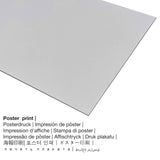John Henry Twachtman, 1889 - Icebound - fine art print
Tax included. Shipping calculated at checkout.
Article summary
"Icebound" was created by the male American artist John Henry Twachtman in the year 1889. The 130 years old work of art was painted with the size: 64, 2 × 76,6 cm (25 1/4 × 30 1/8 in) and was painted with the medium oil on canvas. The artwork's inscription is the following: "signed, lower right : "J. H. Twachtman"". Today, the artwork can be viewed in in the digital art collection of Art Institute Chicago in Chicago, Illinois, United States of America. With courtesy of: Art Institute Chicago (public domain). : Friends of American Art Collection. In addition to this, the alignment is in landscape format and has a side ratio of 1.2 : 1, which implies that the length is 20% longer than the width. The painter John Henry Twachtman was an artist from United States, whose style can be classified as Impressionism. The North American painter was born in the year 1853 in Cincinnati, Hamilton county, Ohio, United States and passed away at the age of 49 in the year 1902 in Gloucester, Essex county, Massachusetts, United States.
Select your product material
In the product dropdown menu you can pick the size and materialaccording to your personal preferences. You can choose your your favorite size and material among the following options:
- Aluminium dibond: This is a metal print made on alu dibond material with an impressive depth. Colors are bright and luminous in the highest definition, details appear clear and crisp, and there’s a matte look you can literally feel.
- Printed poster (canvas material): Our poster print is a UV printed canvas paper with a slightly rough surface finish, that resembles the original version of the work of art. A print poster is appropriate for framing your art replica with the help of a custom frame. Please keep in mind, that depending on the size of the poster we add a white margin of around 2-6cm around the work of art, which facilitates the framing with a custom frame.
- Canvas print: The canvas print is a printed canvas mounted on a wooden frame. The advantage of canvas prints is that they are relatively low in weight, which implies that it is quite simple to hang your Canvas print without any wall-mounts. Because of thatcanvas prints are suitable for all kinds of walls.
- Acrylic glass print: The print on acrylic glass, often described as a print on plexiglass, will convert an artwork into great décor and forms a distinct alternative to canvas or aluminium dibond prints.
Legal note: We try all that we can to describe the products in as much detail as possible and to showcase them visually in our shop. At the same time, the colors of the printed materials, as well as the print result might differ somehwat from the representation on your device's monitor. Depending on the screen settings and the condition of the surface, colors might not be printed as realistically as the digital version on this website. Considering that all the art reproductions are processed and printed by hand, there might also be minor deviations in the motif's exact position and the size.
Article specs
| Article categorization: | art reproduction |
| Method of reproduction: | reproduction in digital format |
| Production process: | UV print / digital printing |
| Product Origin: | produced in Germany |
| Stock type: | production on demand |
| Product usage: | home décor, wall decoration |
| Artwork alignment: | landscape alignment |
| Aspect ratio: | 1.2 : 1 - length : width |
| Image aspect ratio implication: | the length is 20% longer than the width |
| Fabric choices: | poster print (canvas paper), canvas print, acrylic glass print (with real glass coating), metal print (aluminium dibond) |
| Canvas on stretcher frame (canvas print) options: | 60x50cm - 24x20", 120x100cm - 47x39", 180x150cm - 71x59" |
| Acrylic glass print (with real glass coating) sizes: | 60x50cm - 24x20", 120x100cm - 47x39" |
| Poster print (canvas paper) sizes: | 60x50cm - 24x20", 120x100cm - 47x39" |
| Aluminium print options: | 60x50cm - 24x20", 120x100cm - 47x39" |
| Framing of the art copy: | not available |
Artpiece table
| Title of the artwork: | "Icebound" |
| Categorization of the work of art: | painting |
| Generic term: | modern art |
| Century: | 19th century |
| Year of creation: | 1889 |
| Artwork age: | more than 130 years old |
| Artwork original medium: | oil on canvas |
| Original size: | 64, 2 × 76,6 cm (25 1/4 × 30 1/8 in) |
| Original artwork inscription: | signed, lower right : "J. H. Twachtman" |
| Museum / collection: | Art Institute Chicago |
| Place of the museum: | Chicago, Illinois, United States of America |
| Website Museum: | www.artic.edu |
| License type of artwork: | public domain |
| Courtesy of: | Art Institute Chicago |
| Creditline of artwork: | Friends of American Art Collection |
Artist details table
| Artist: | John Henry Twachtman |
| Other artist names: | Twachtman John Henry, Twachtman John H., twachtman j.H., john h. twachtman, twachtmann john H., twachtman J.H., j.h. twachtman, Twatchman John Henry, John Henry Twachtman, Twachtman, twachtman john |
| Artist gender: | male |
| Artist nationality: | American |
| Jobs: | painter |
| Country: | United States |
| Artist category: | modern artist |
| Art styles: | Impressionism |
| Lifespan: | 49 years |
| Year of birth: | 1853 |
| Born in (place): | Cincinnati, Hamilton county, Ohio, United States |
| Died in the year: | 1902 |
| Deceased in (place): | Gloucester, Essex county, Massachusetts, United States |
This text is copyrighted ©, Artprinta (www.artprinta.com)
Additional artwork information from Art Institute Chicago (© Copyright - Art Institute Chicago - Art Institute Chicago)
During the last decade of his life, John Henry Twachtman frequently painted views of the landscape surrounding his home on Round Hill Road in Greenwich, Connecticut. In a departure from typically barren images of winter, he enjoyed depicting the beauty of the frozen terrain, believing that it was conducive to contemplation and regeneration. The dense, gradually built-up layers of paint in Icebound mimic the accumulation of snow on frozen ground, and the sinuous curves that define the snow and ice against the water suggest movement in an otherwise tranquil environment. Almost square in format, the painting’s harmonious composition exemplifies Twachtman’s opinion that “never is nature more lovely than when it is snowing.”














